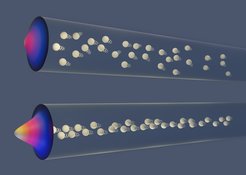When magnetotactic microswimmers condense like cold atoms

Due to the effect of the magnetic and flow fields, the magnetotactic swimmers are focused at the center of the channel. For low swimmer densities (higher panel), their positions and orientations fluctuate such that their distribution with respect to the channel center is relatively spread, while at high enough densities (lower panel) magnetic interactions between the swimmers lead them to self-organize into a condensate at the channel center, resulting in a more peaked distribution.
Contrary to inanimate ‘passive’ matter, motile ‘active’ matter is not constrained by the conservation laws of usual thermodynamics. This means that active matter cannot reach the state of equilibrium, but constantly spends energy in order to e.g. achieve motion. For more than twenty years now, it thus constitutes a playground for researchers who keep discovering and studying exotic states of matter that have no counterpart at thermodynamic equilibrium. Among all types of swimmers, those said magnetotactic - whose motion follows magnetic field lines, be they bacteria that developed a specialized organ allowing them to feel magnetic fields or engineered micro-robots- are of particular interest on both fundamental and practical levels. Indeed, as magnetic actuation is non-invasive and biologically compatible, magnetic micro-robots are promising candidates for bio-medical applications such as targeted drug delivery. Moreover, collections of such swimmers are incredibly complex objects of study, as each of such individuals generates its own magnetic field that influences the motion of all the others. The resulting interactions, when combined with self-propulsion and external driving by applied magnetic field or flow, can lead to fascinating collective behaviors.
In a new paper published in Physical Review Letters, a team of researchers, led by Ramin Golestanian, Director of the Living Matter Physics Department at the Max Planck Institute for Dynamics and Self-Organization, show that magnetotactic swimmers confined in a microfluidic channel exhibit a new type of collective behavior resulting in a phase that can formally be described as a classical analogue of a Bose-Einstein Condensate (BEC).
Bose-Einstein Condensation in active matter
Boson - named after the Indian physicist Satyendra Nath Bose - is a term denoting a class of quantum objects which have the property to be able to occupy the same quantum state, such as spin or energy. ‘‘Due to this peculiar feature, when cooled down at nearly absolute zero temperature, bosons such as Helium-4 or other atomic gases, will all condense into the same quantum state and thus form a single macroscopic object with quantum properties”, says Benoît Mahault who is a co-author of the study. Such a state of matter is named a Bose-Einstein Condensate, as first predicted in the 1920’s by Albert Einstein.
Magnetic microswimmers, however, usually evolve at room temperature, and are thus not subject to the rules of quantum mechanics. Despite this, the numerical simulations and theory developed by Golestanian and collaborators suggest that when embedded in a microfluidic channel in the presence of an externally applied magnetic field and a shear flow, such swimmers are able to form condensates that can be described analogously to the BEC. ‘‘The combined effect of the magnetic and flow fields acts as if the swimmers were in an effective potential well, which naturally attracts them to the center of the channel”, says Fanlong Meng, the first author of the study. ‘‘But such microscopic particles are subject to fluctuations in their positions and directions of swimming, which counter-balance their accumulation and prevent any kind of large-scale clustering”, he adds. The description in terms of non-interacting swimmers, however, breaks down when their density exceeds a certain threshold. “Then, the attractions between the swimmers are strong enough to overpower the effect of fluctuations, resulting in a macroscopic number of them to remain trapped and line up at the channel center”, explains Golestanian. Remarkably, the theoretical framework developed by the authors shows that the macroscopic description of this clumping behavior features strong similarities with the BEC, despite the two phenomena originating from distinct physical processes.
The different phases of magnetic swimmers
This is not the first time that Prof. Golestanian’s group unveils the origin of a remarkable collective behavior of magnetotactic swimmers. In a previous publication (Fanlong Meng, Daiki Matsunaga, and Ramin Golestanian, „Clustering of Magnetic Swimmers in a Poiseuille Flow“, Phys. Rev. Lett. 120 (2018) 188101), they could indeed elucidate how magnetic interactions between swimmers contribute to their self-organization in packets traveling along the channel. “These former results were obtained outside of the condensation regime”, specifies Mahault, “which led us to revisit them”. This way, the authors could provide a phase diagram detailing all the dynamical regimes of magnetotactic swimmers. “Our theoretical model is moreover detailed enough to allow for direct comparisons with experiments using biological or artificial swimmers”, adds Golestanian. The authors conclude that the findings not only enrich the broad set of collective dynamics exhibited by active matter systems, but also draw interesting parallels across physics disciplines and provide guidelines for future designs of controllable functional micro-robotic systems with desired emergent properties.
